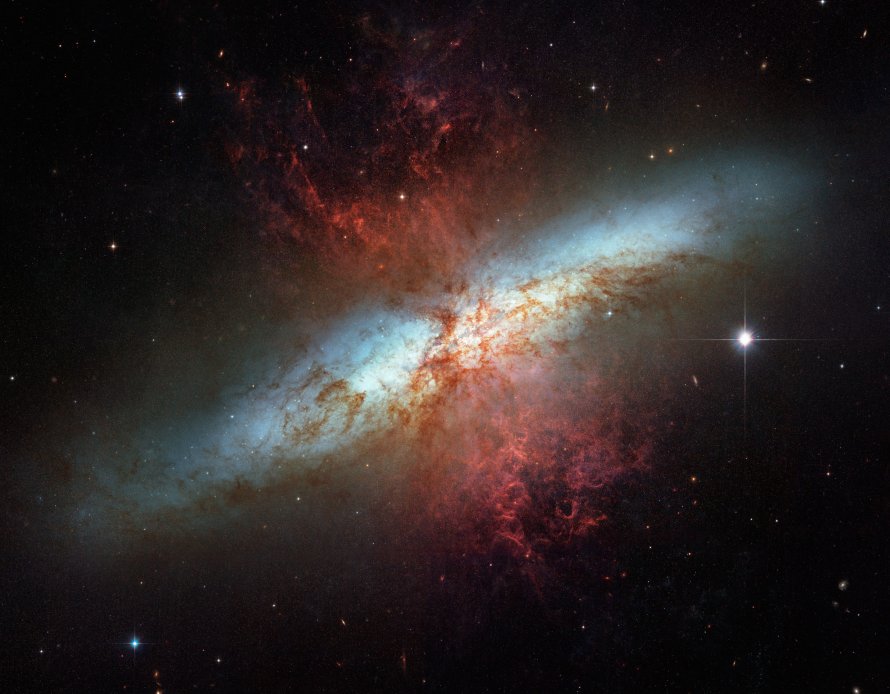M82 (NGC 3034) - Cigar Galaxy
Messier 82 (NGC 3034), also known as the Cigar Galaxy, is an irregular galaxy located in the constellation Ursa Major in the M81 Group of galaxies. M82 is 12000000 light years away from Earth.
M82 is best viewed during late spring, is magnitude 8.4, and can be viewed with binoculars. M82 is 11.2' x 4.3' in apparent size. For reference, the full moon is 30'.
Observing difficulty: Easy
- Name:
- Cigar Galaxy
- Type:
- irregular galaxy
- Constellation:
- Ursa Major
- NGC or IC:
- NGC 3034
- Magnitude:
- 8.4
- Viewing:
- binoculars
- Size:
- 11.2' x 4.3'
- Distance (light years):
- 12000000 LY
- RA:
- 9h 55.9m
- Dec:
- 69 41'
- Season:
- late spring
- Galaxy group:
- M81 Group
- Messier Marathon #:
- 35
* The naked eye can see up to magnitude ~7-8 objects under ideal dark sky conditions.
A Detailed Examination of the Cigar Galaxy
Messier 82, commonly known as the Cigar Galaxy due to its elongated, cigar-like shape, is a captivating starburst galaxy located in the Ursa Major constellation. With its unique morphology and intense star-forming activity, M82 provides an intriguing target for both amateur astronomers and astrophysicists.
Characteristics of M82
M82 is the archetypal starburst galaxy, characterized by an exceptional rate of star formation. The intense star-forming activity is concentrated in the central region, and it is believed to have been triggered by interactions with its close neighbor, the spiral galaxy M81. Such galactic interactions can compress gas and dust, triggering the birth of new stars.
The strong stellar winds and supernovae from these massive new stars create 'superwinds,' which are powerful outflows of gas from the galaxy. These superwinds are so strong that they can be seen extending out from the galactic disk in optical and X-ray images. This outflow of material is a defining characteristic of M82 and contributes to its distinctive, irregular appearance.
Magnitude and Size
M82 has an apparent magnitude of 8.4, making it a good target for small telescopes and even binoculars under favorable conditions. In terms of size, M82 is approximately 11.2 by 4.3 arcminutes in size, which corresponds to a physical dimension of roughly 37,000 light-years. The galaxy's brightness and relatively large size in the sky make it an excellent target for amateur astronomers interested in observing galaxies.
Finding and Viewing M82
M82, like its companion M81, is located in the Ursa Major constellation and is relatively easy to locate. The pair of galaxies can be found by extending a line from Phecda to Dubhe, two stars in the bowl of the Big Dipper asterism, and continuing the line a similar distance further. Given their proximity, both M82 and M81 can often be seen in the same field of view, offering a striking contrast between a spiral and a starburst galaxy.
In a small telescope or binoculars, M82 appears as a faint, elongated smudge of light. Under darker skies and with larger telescopes, some of the structure and mottling of the galaxy's disk can be discerned. Observers may also note the galaxy's irregular, disturbed appearance, which hints at the turbulent processes occurring within.
M82 is not only a fascinating galaxy to observe, but it also offers rich opportunities for scientific study. By examining galaxies like M82, astronomers can gain insights into the processes of star formation and galaxy evolution, helping to unravel the complex history of our universe.



